Michelangelo Sculptures – Discover Famous Michelangelo Statues
Although Michelangelo was skilled in numerous disciplines, he was best known as a sculptor. Producing in this field, he rose to prominence in Italy’s Renaissance period. This sculptor identified a link between the soul and the human form, meticulously researching human anatomy throughout his life. This understanding would subsequently bring Michelangelo’s sculptures to life to a degree previously unreached in the Renaissance era. This article will explore the most famous Michelangelo statues such as The Deposition (1547), and seek to uncover the most renowned Renaissance sculpture by Michelangelo.
Michelangelo, the Famous Sculptor
| Artist Name | Michelangelo di Lodovico Buonarroti Simoni |
| Nationality | Italian |
| Date of Birth | 6 March 1475 |
| Date of Death | 18 February 1564 |
| Place of Birth | Caprese Michelangelo, Italy |
Michelangelo di Lodovico Buonarroti Simoni is regarded as one of the most innovative and significant creative minds in Western art history, and his best-known artworks have become cultural icons across the world. Michelangelo spent the majority of his time in Rome and Florence, two prominent political and cultural hubs during his lifetime.
His works were admired and coveted for their inventive compositions and striking portrayals of the human figure.
The Most Renowned Michelangelo Sculptures
Light and shadow were effectively utilized to give Michelangelo’s statues a more realistic appearance; he would also occasionally curl and twist his figures together to suit the overall arrangement. The expanding reputation of Michelangelo’s works drew new commissions in a range of fields, but Michelangelo’s statues were always his favorite medium for displaying his talent. Any Renaissance sculpture by Michelangelo can be seen as an exemplar of the best of what the era had to offer.
The legacy of Michelangelo’s works, however, extends far beyond the Renaissance period and are still analyzed and admired to the present day.
St. Petronius (1495)
| Date Completed | 1594 |
| Medium | Marble |
| Dimensions (cm) | 64 |
| Current Location | Basilica of San Domenico, Bologna, Italy |
During the fifth century, St. Petronius was the bishop of Bologna. The statue is situated inside the Basilica of San Domenico, which a young Michelangelo helped to improve by making a few embellishments. St Petronius, while not his most renowned work, is a great artwork, that like many of Michelangelo’s works, conveys an engaging tale about a specific individual.
Not much is known about this specific character, other than the fact that he converted to Christianity and was appointed Bologna’s bishop shortly after.
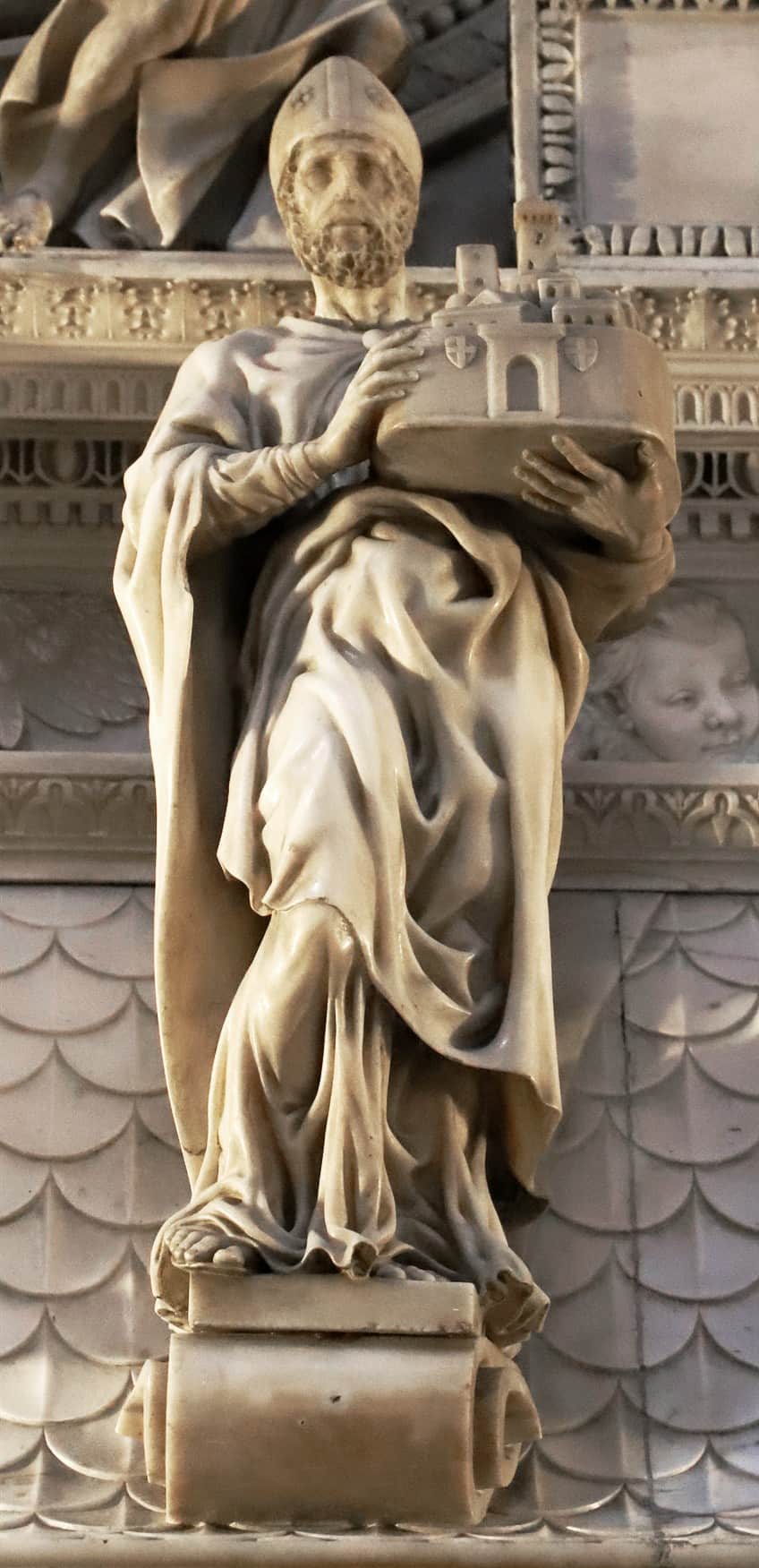
St. Petronius is seen in Michelangelo’s statue carrying a miniature of Bologna. The statue has several deep carvings that expose a lot of detail and shadows. These extraordinary deep carvings are especially visible in his robe, beard, and the empty region behind his arms at chest level. The sculpture also indicates some sort of motion.
If the visitor looks at St Petronius’ feet, they will see that the right foot is stepping, implying the saint’s vigorous activities in Bologna and elsewhere.
Bacchus (1497)
| Date Completed | 1497 |
| Medium | Marble |
| Dimensions (cm) | 203 |
| Current Location | Palazzo del Bargello, Florence, Italy |
Michelangelo was recognized for his exceptional talent, particularly in sculpting, from the beginning of his career. One of his earliest pieces, Bacchus, depicts the Roman Deity of wine holding grapes and a glass. A faun, half goat, half man, waits behind him, devouring grapes that fall from his hands.
Bacchus was made in 1497 in response to a request from Raffaele Riario, who later rejected the sculpture.

It’s possible that the high center of balance on this statue mocked the Roman Deity, implying intoxication coupled with the statue’s rolling eyes. Whatever the reason for its rejection, this work finally found a new home in Michelangelo’s acquaintance Jacopo Galli’s Garden.
The degree of detail on this Michelangelo statue, like with all of the artist’s works, is remarkable; it’s clearly apparent why he is regarded as one of the finest sculptors of all time.
Pietà (1499)
| Date Completed | 1499 |
| Medium | Carrara marble |
| Dimensions (cm) | 195 |
| Current Location | St. Peter’s Basilica, Vatican City |
In 1497, French Cardinal Lagraulas contracted Michelangelo to produce the most exquisite marble sculpture in Rome, one that no contemporary sculptor could surpass, for the cardinal’s eventual mausoleum in Old St. Peter’s Basilica. Few would deny that the young sculptor not only met but also exceeded the Cardinal’s objective with the sculpture.
The statue was carved from a single piece of Carrara marble, which he thought was the most exquisite slab of marble he had ever produced with.
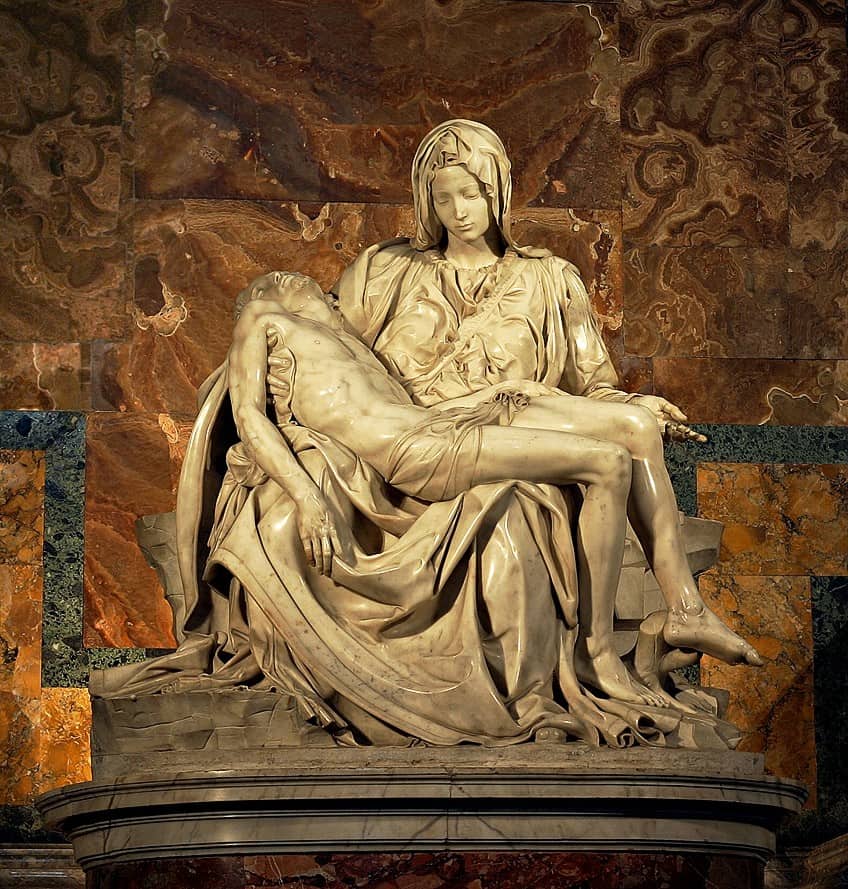
He also stated that he could “see” the artwork within the stone and that all he had to do was eliminate the superfluous to release the figure that existed inside. One of the earliest and most renowned of Michelangelo’s statues, it portrays the lifeless corpse of Jesus after his crucifixion lying across the lap of his mother as she weeps over his figure.
Michelangelo was a devout Catholic, and the sculpture is an emotive work undoubtedly motivated by his intense and enduring faith.
David (1504)
| Date Completed | 1504 |
| Medium | Carrara marble |
| Dimensions (cm) | 517 |
| Current Location | Galleria dell’Accademia, Florence, Italy |
The gigantic slab of Carara marble from which the sculpture of David was fashioned had been abandoned 40 years before by Agostino Di Duccio, another sculptor of the Renaissance period. Di Duccio had started initially working on molding sections of the feet, legs, and torso, but lacked the motivation and dedication to bring the sculpture through to fruition.
The representatives of the Guild of Wool in Florence persuaded Michelangelo to recommence the project in 1499, and the sculpture was concluded in 1604.
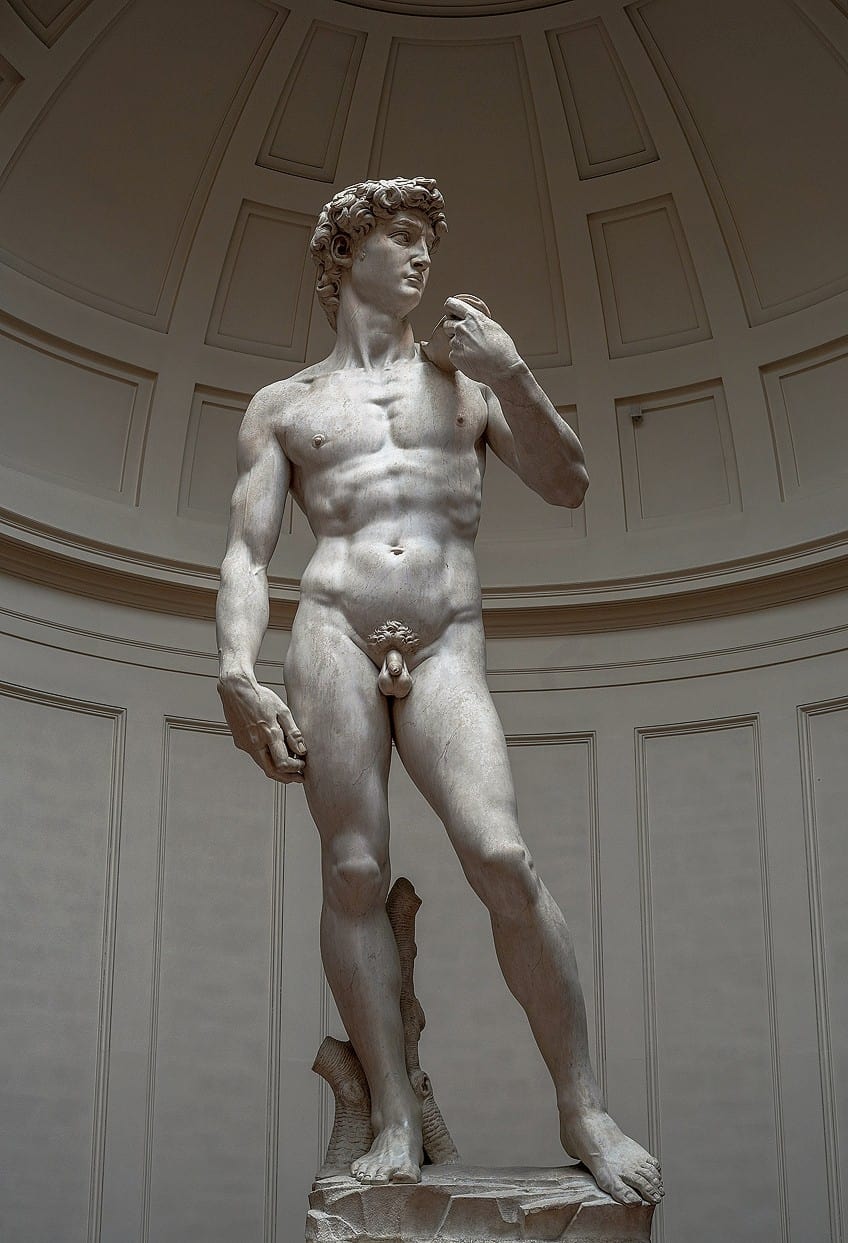
It is regarded by many as the most famous of Michelangelo’s sculptures. One could at first assume that the artist might empathize with the theme of the giant against the underdog on a personal level. This might explain why it is so large, as it represents the scriptural subject’s spiritual strength over his adversary, Goliath, the warrior commander of the Philistines.
Rebellious Slave (1513)
| Date Completed | 1513 |
| Medium | Marble |
| Dimensions (cm) | 215 |
| Current Location | Louvre Museum, Paris, Italy |
Michelangelo created some notable artworks that are instantly recognizable across the world. This includes the Rebellious Slave. It depicts four separate characters, all of whom are frequently portrayed as slaves or captives. Each one may be differentiated from the others by subtle variances in their stance and physical characteristics. As a result, they have been given their names. With this series of Michelangelo statues, he addresses themes of liberty.
Michelangelo’s abilities as a tactician are evident in his determination to complete this work.
Rebellious Slave (1513) by Michelangelo; Jörg Bittner Unna, CC BY-SA 3.0, via Wikimedia Commons
He selected a theme that will likely always connect with people throughout the world, guaranteeing that his art will always have a place within society. He is one of the greatest artists to try to approach such a difficult subject. He elicits feelings that individuals often chose to suppress for the sake of political necessity or their physical well-being.
Dying Slave (1516)
| Date Completed | 1516 |
| Medium | Marble |
| Dimensions | 215 |
| Current Location | Louvre Museum, Paris, France |
Both this piece and Rebellious Slave were created as part of Michelangelo’s work on the updated designs for Pope Julius II’s mausoleum, which was requested from him in 1513. They were supposed to be two of a group of captives who would have featured on the bottom level of the tomb if they hadn’t been cut from the designs for the finished version finished in 1545.
Only in the 19th century were these sculptures referred to as “slaves”.
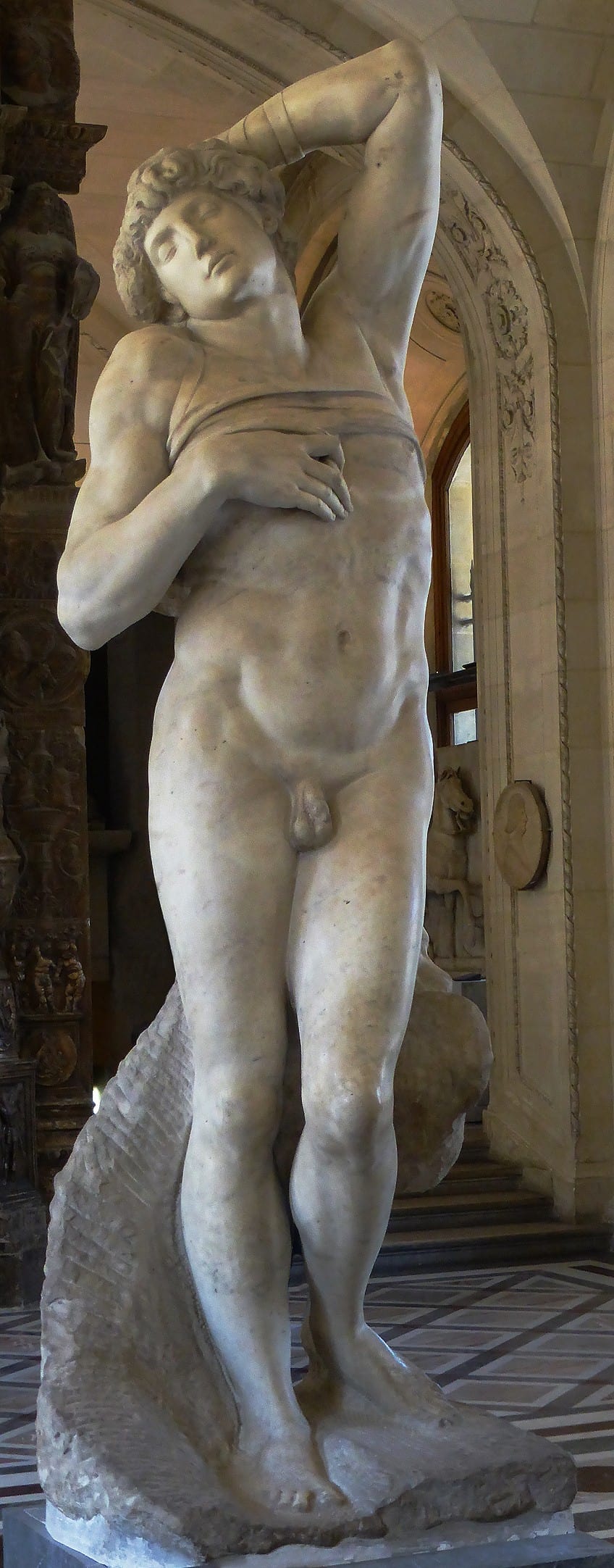
In appreciation for his excellent hospitality, Michelangelo later offered these two statues to Roberto Strozzi. It has been suggested that Michelangelo depicted in this sculpture the moment that, on the verge of death, the organism is emptied of the last of its energy to become simply a dead vessel.
He depicts a young adolescent lost in a condition of malaise and resignation of his liberation from life’s challenges.
Risen Christ (1521)
| Date Completed | 1521 |
| Medium | Marble |
| Dimensions (cm) | 205 |
| Current Location | Santa Maria Sopra Minerva, Rome, Italy |
Metello Vari was the individual that commissioned Michelangelo’s masterpiece in 1514. His sole condition was that Christ carries the cross in his arms. Aside from this one requirement, Michelangelo was allowed to style the remainder of the statue and visual design.
His first effort, while working in his studio in 1515, was unfortunately abandoned owing to a black line that ran across the marble.
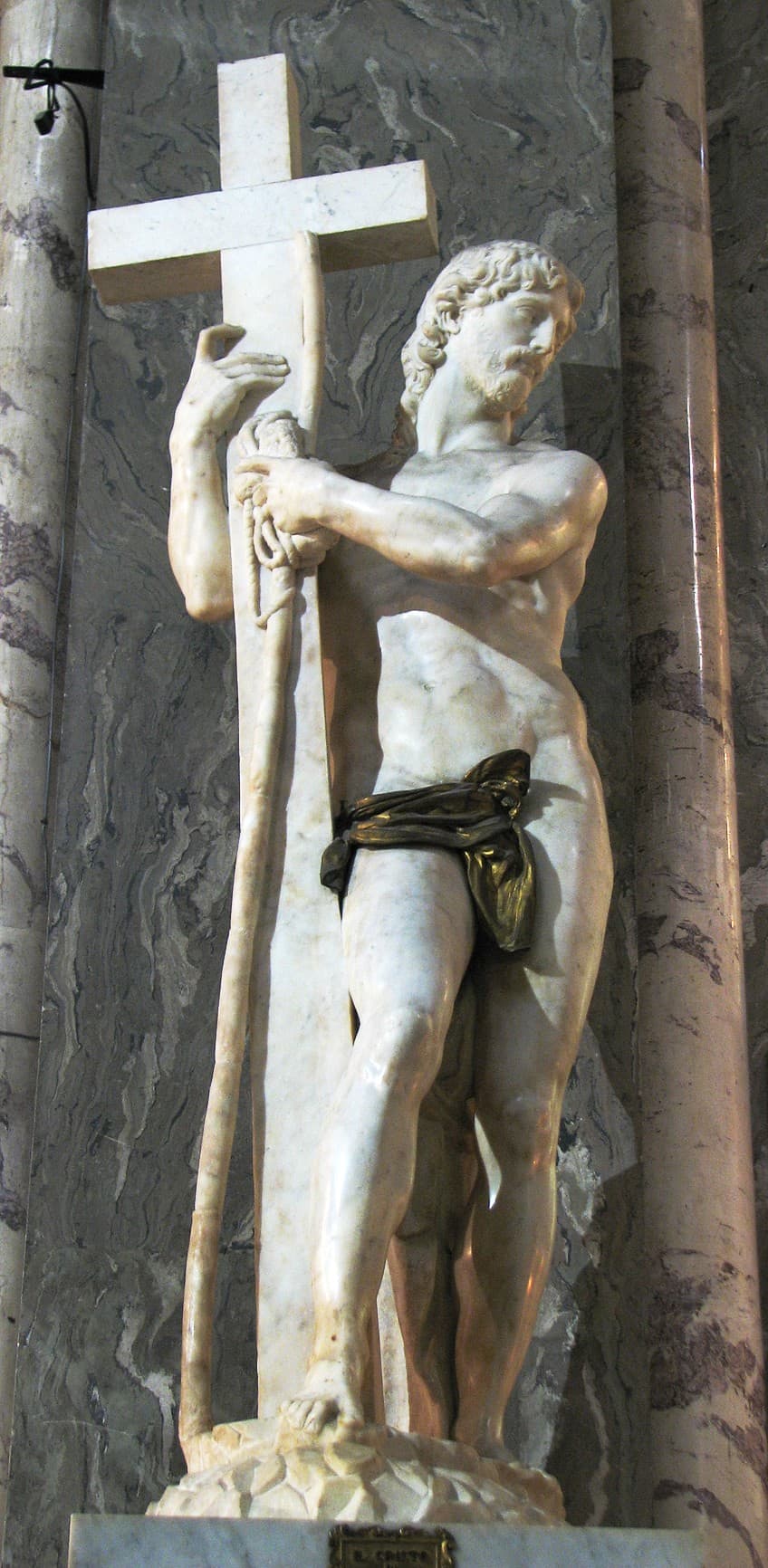
He focused on this piece while living in Florence and then later in Rome. This rendition of the Risen Christ was later presented to Metello Vari in 1522, and he housed it in his garden near Santa Maria Sopra Minerva. The location of the original first iteration of the statue is unknown, except that it was apparently offered for auction in 1607, and nothing further was written about this remarkable statue until 2000.
Apollo (1530)
| Date Completed | 1530 |
| Medium | Marble |
| Dimensions (cm) | 146 |
| Current Location | Bargello National Museum, Florence, Italy |
Some experts believe that this monument was not sculpted by Michelangelo at all, because the sculptor left no notes concerning it. Sources from the time vary regarding its interpretation: the person is identified as David in Duke Cosimo I’s 1553 inventory, whereas it is identified as Apollo by Vasari.
The sculpture represents a naked man with intricate contouring and twisting that allows numerous features of the body to be viewed from a single perspective.

Both the right leg and the left arm are twisted. If this is actually David instead of Apollo, the psychological weight on the figure’s head stands out as a dramatic contrast to Michelangelo’s own world-famous David. Far from rejoicing in the fall of his colossal adversary – assuming the incomplete mound does indeed show Goliath’s head as some critics believe – he looks depressed, as though feeling guilt for the brutality with which he had killed him.
Crouching Boy (1530)
| Date Completed | 1530 |
| Medium | Marble |
| Dimensions (cm) | 54 |
| Current Location | State Hermitage Museum, Saint Petersburg, Russia |
Today, this statue is located in Saint Petersburg’s Hermitage Museum, where it is the sole piece by Michelangelo in the museum’s collection. It is a little, unfinished marble sculpture of a youngster, nude and kneeling, maybe to care for his damaged foot. The boy’s physique is highly developed, with obvious muscle, and his crouched form hints at the inner strength he carries.
The boy’s head is tilted downwards as he focuses on his foot, unaware of everything happening around him, adding to the piece’s impression of misery and suffering.
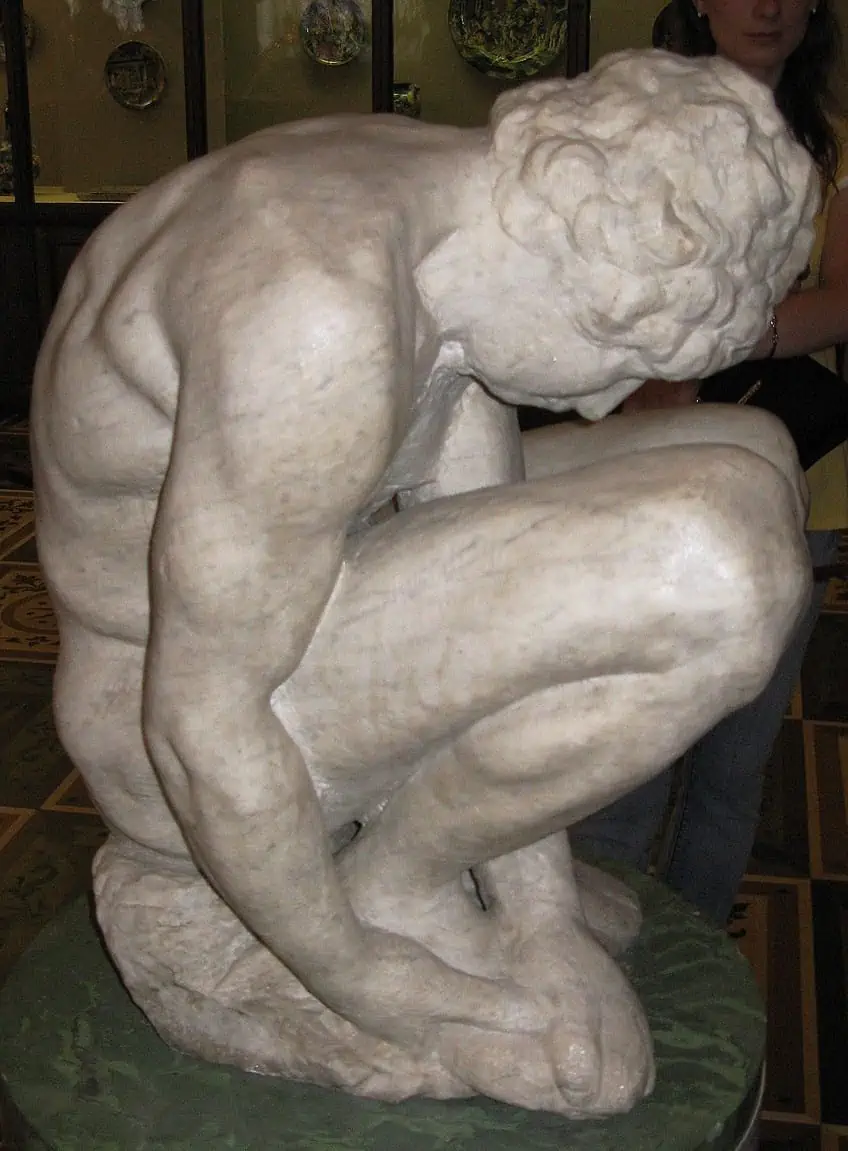
Nonetheless, the work remains perplexing. Some experts believe the artwork represents the unborn soul, while others believe it represents a wounded soldier. Catherine the Great brought it to Russia when she bought a huge collection of antiques and other objects from John Lyde Browne, the antiquary, and financier from England.
Medici Madonna (1531)
| Date Completed | 1531 |
| Medium | Marble |
| Dimensions (cm) | 226 |
| Current Location | Basilica of San Lorenzo, Florence, Italy |
The statue was once part of the Medici mausoleum and now stands over Lorenzo the Magnificent’s grave. It was placed between the sculptures of Damian and Cosmas, the Medici’s patron saints. As is obvious in most of Michelangelo’s works, he was captivated by the Virgin Mary and the infant subject, and this Madonna is no exception.
The statue depicts the Virgin carrying the infant Jesus. The child’s face is turned away from the viewer in this marble sculpture, buried in his mother’s bosom.
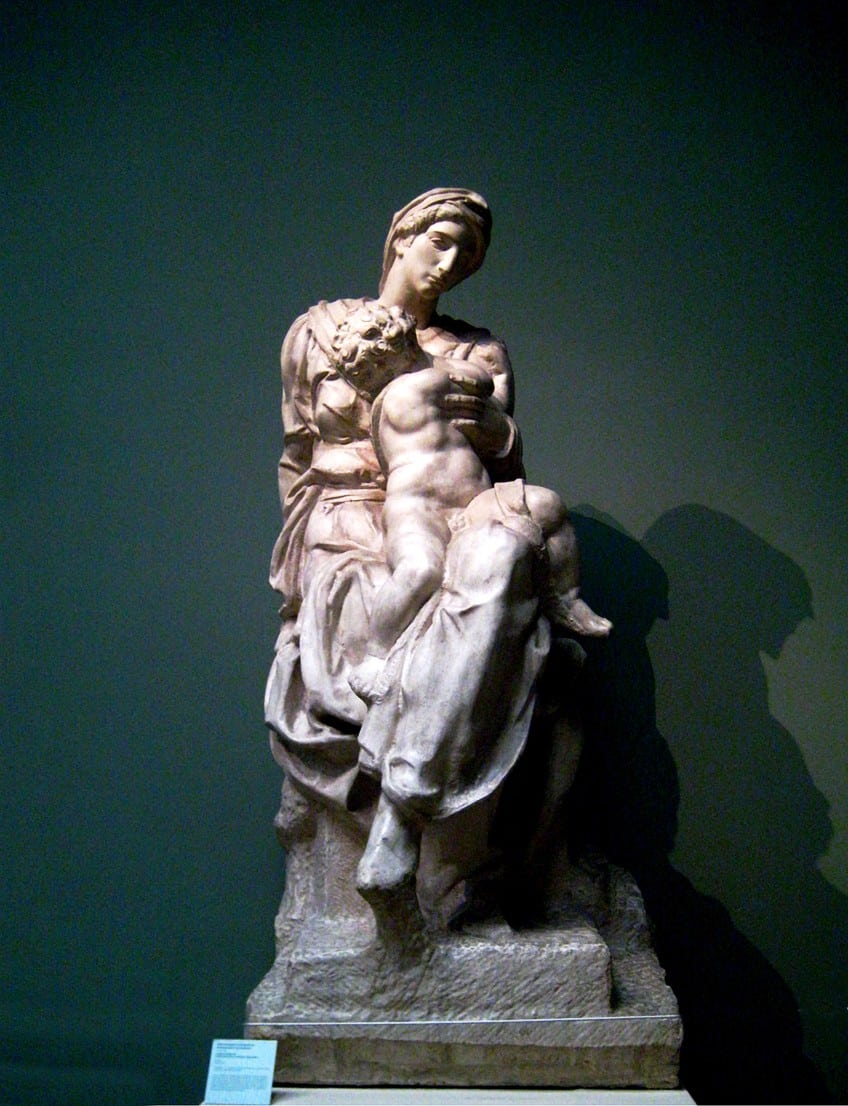
The facial characteristics are not as polished as those in Michelangelo’s Pieta, but they are striking, especially given that the statue is incomplete. The baby’s physique is strong, which may represent the role he would play as the savior of humanity.
Madonna’s grasp on the child is not defensive, as if she has decided he is old enough to release him.
The Genius of Victory (1534)
| Date Completed | 1534 |
| Medium | Marble |
| Dimensions (cm) | 261 |
| Current Location | Palazzo Vecchio, Florence, Italy |
The marble figure was created as part of the ornamentation for Pope Julius II’s grave. There is substantial uncertainty concerning the figure’s creation date as well as its original purpose. Even though the exact date of the figure’s creation is unknown, it is assumed that 1534 is correct, as this is when the sculpture would have been required to be put in one of the tomb’s recesses.
Because of the muscular and flowing posture that was created of the triumphant young man, which was characteristic of the era and was emblematic of the Slave movement, it is thought that the sculpture was to be put at Julius the Second’s grave.
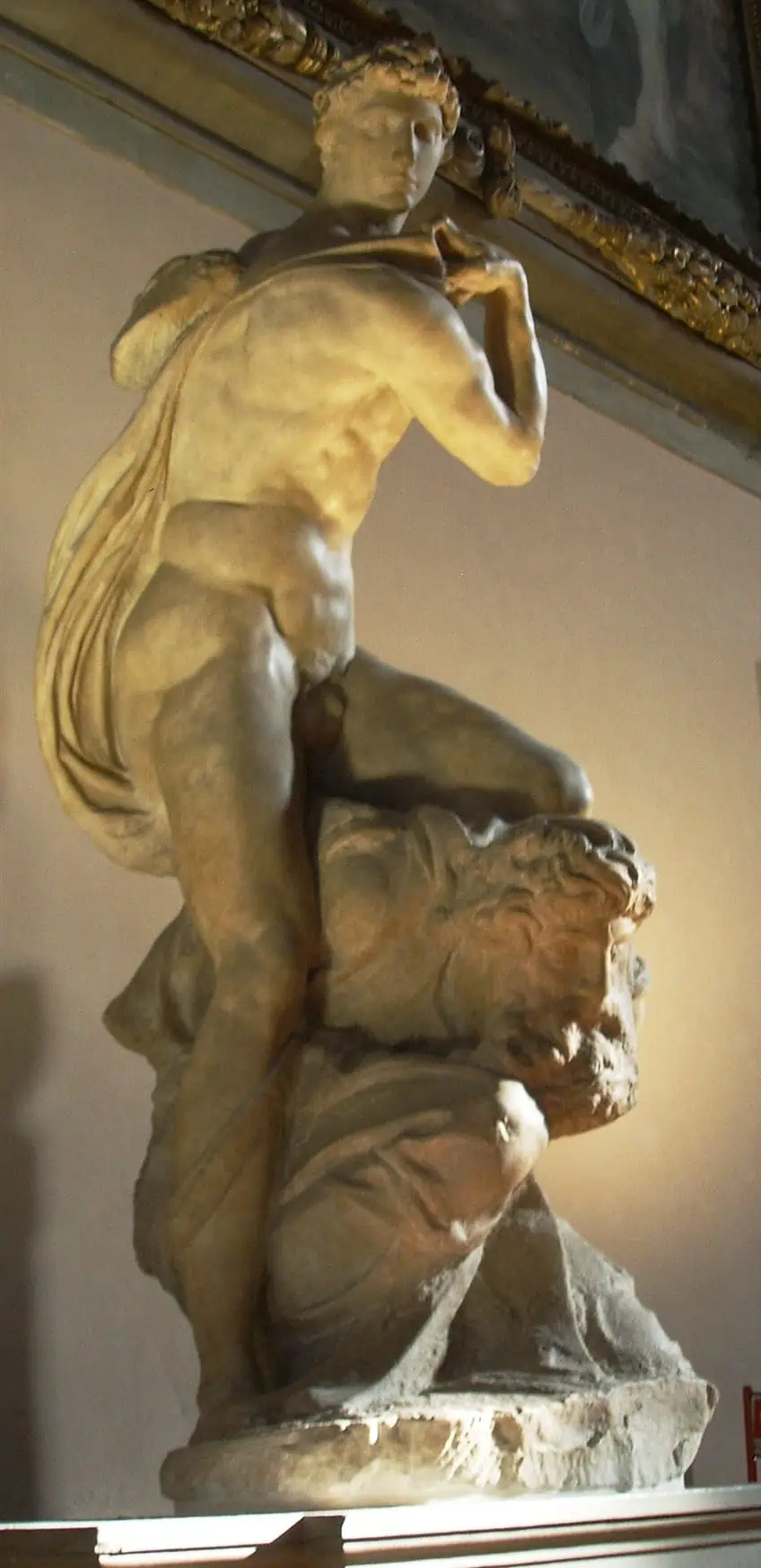
Another idea is that the sculpture was part of an incomplete project, as it was planned to be combined with other statues depicting war and triumph. The sculpture was left to Michelangelo’s nephew when he abandoned it in his studio upon leaving Florence.
Bearded Slave (1536)
| Date Completed | 1536 |
| Medium | Marble |
| Dimensions (cm) | 263 |
| Current Location | Florence Academy of Fine Arts, Florence, Italy |
This amazingly lifelike figure is one of four incomplete sculptures known as the Boboli slaves. Commissioned for Pope Julius II’s tomb, it is a physically well-developed, nude male with just a band of linen around his legs. The stance shown is one of physical anguish. The slave’s matted head is partly twisted and leaned on his left shoulder. The right arm is lifted, and something looks to be held above his head.
Because this section of the carving is incomplete, it is unclear what the right hand is grasping, but the unbalanced stance suggests that he is holding something heavy.
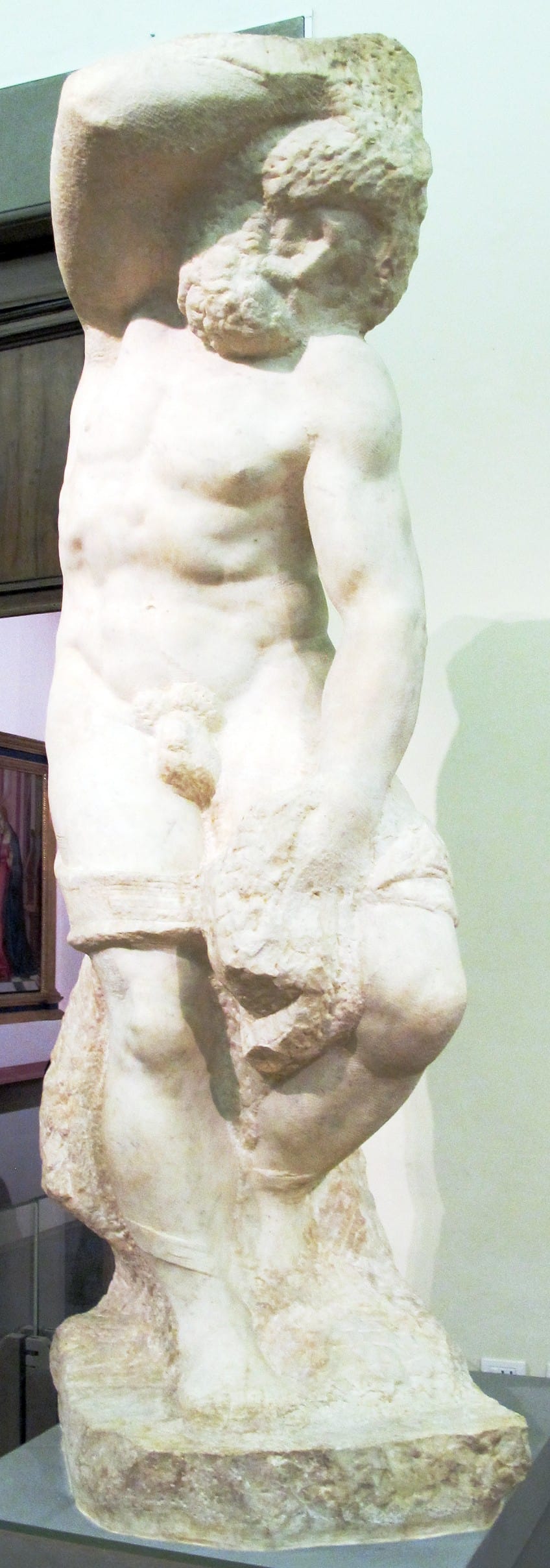
The modeling of the legs is not as accurate as the remainder of the statue, and it is possible that it was completed subsequently by someone else. The image of the slaves appears to be imprisoned by the material of their manufacture and fighting to liberate themselves, which adds to the mystique of these incomplete sculptures. It’s debatable if that was Michelangelo’s aim though.
Brutus (1538)
| Date Completed | 1538 |
| Medium | Marble |
| Dimensions (cm) | 74 |
| Current Location | National Museum of the Bargello, Florence, Italy |
While this piece is incredibly beautiful and elicits intense emotions as a result, it also makes a strong political message. Fans of Michelangelo’s sculptures may not necessarily contemplate his political views. Regarding this important component of his work, ignoring the sculptor’s background means missing the complexity of some of Michelangelo’s works and their relevance in the social atmosphere of the period.
The Medici’s as a family had built a name that is as well-known, if not more so, than the artist.
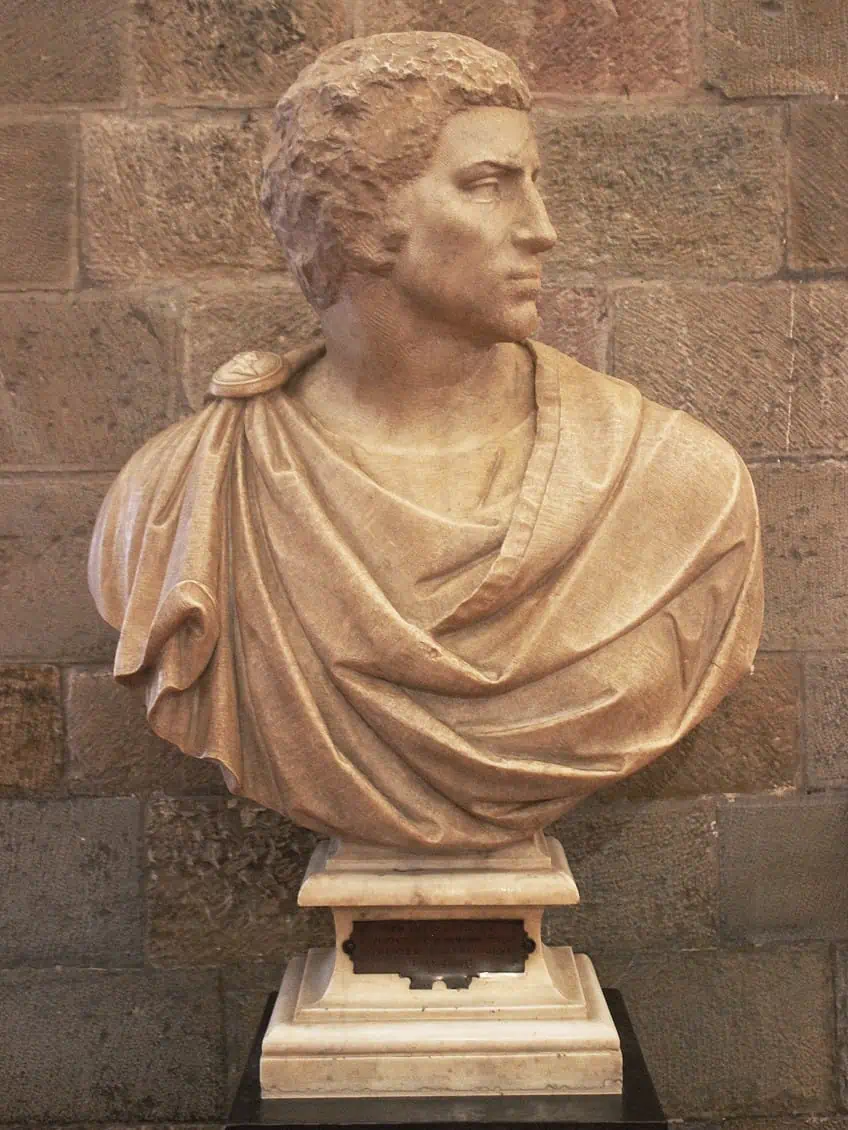
In the sculpture, the head displays a calm serenity and exceptional vigor that blend strikingly with scorn, wrath, and hatred, which is demonstrated in the manner it is thrown to one side. This sculpture depicts the sculptor’s portrayal of the conniving Roman politician who plotted Julius Caesar’s demise.
The Deposition (1547)
| Date Completed | 1547 |
| Medium | Marble |
| Dimensions (cm) | 277 |
| Current Location | Museo dell Opera del Duomo, Florence, Italy |
Michelangelo appears to have relished his leisurely approach to creating the statue, although his servant, Urbino, was keen for him to complete it. The sculptor had selected veined marble, which is more challenging to carve. It is unknown if these two reasons directly led to Michelangelo’s fury, but he just had enough one day.
Taking up his hammer, he continuously hit the statue, breaking its left arm and leg and destroying numerous pieces.

After this event, he couldn’t complete the artwork and handed it to a rich businessman, Francesco Bandini. Another interpretation argues that Michelangelo was dissatisfied with his modeling of Christ’s leg, which appeared to be draped across Nicodemus’ torso. He could have thought this was inappropriately sexual, which would illustrate why he destroyed this area of the sculpture.
Tiberio Calcagni was commissioned to finish The Deposition.
Palestrina Pietà (1555)
| Date Completed | 1555 |
| Medium | Marble |
| Dimensions (cm) | 253 |
| Current Location | Florence Academy of Fine Arts, Florence, Italy |
This sculpture, dating from roughly 1555, has been credited to Michelangelo many times, although this has been cast in doubt in recent years. Gian Lorenzo Bernini or Niccol Menghini appears to be more probable candidates, according to some historians. The sculpture is approximately two and a half meters tall and is located in the Galleria dell’Accademia in Florence, Italy.
It was made entirely of marble, which is compatible with all of the probable names associated with it because marble was the most frequent material for sculpting throughout the Italian Renaissance.
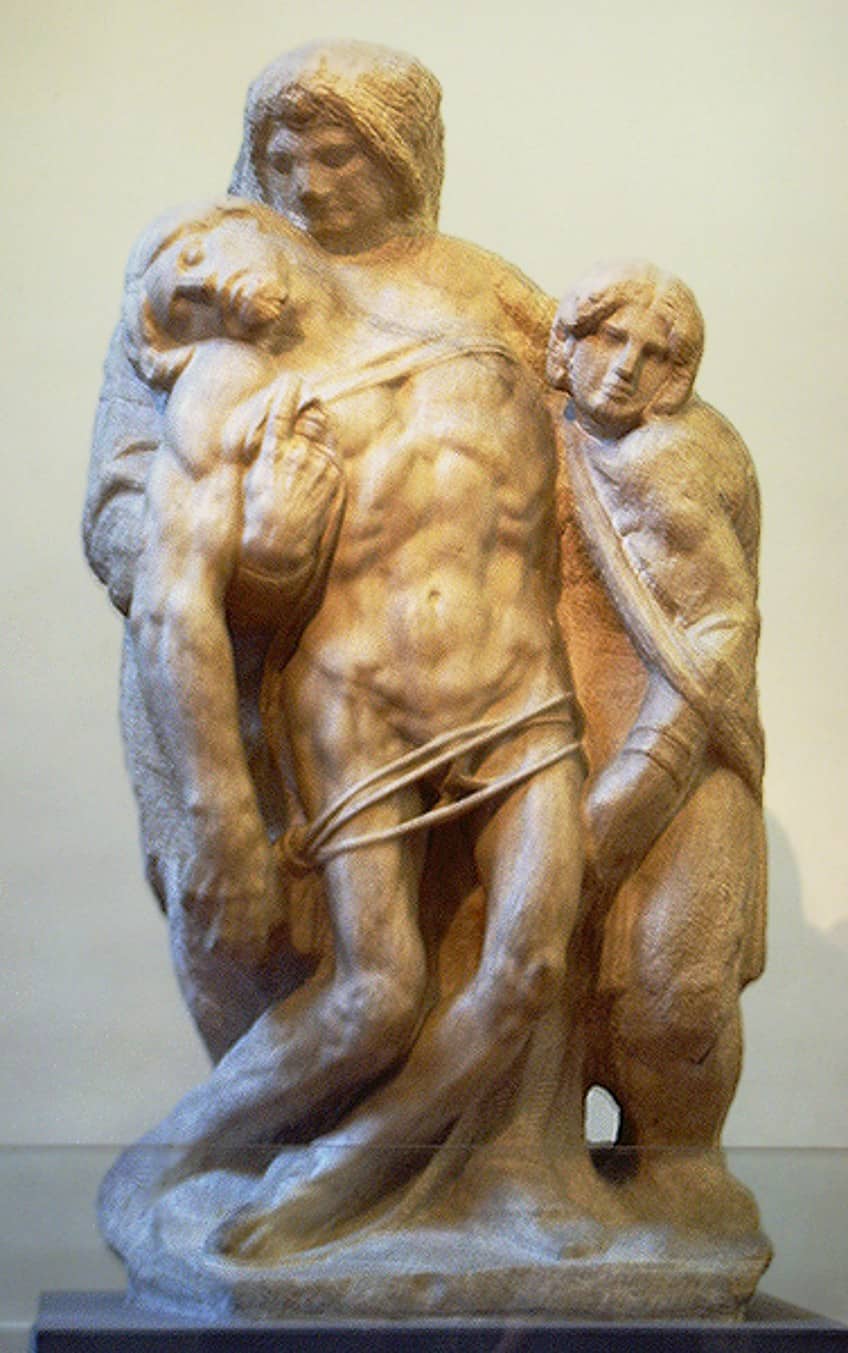
Records suggest that for the first time in 1756, the Palestrina Pietà was ascribed directly to Michelangelo, albeit no evidence can currently be located. The subject and concept are absolutely appropriate for this famous Florentine artist since he made numerous other Pietas throughout his lifetime, but the form of this statue has cast doubt on that claim. Put simply, most scholars think that the design is too rough to be worthy of the great master, while others feel only Michelangelo could have created something so life-like, yet the likes of Bernini and Menghini were also extremely competent, sensitive sculptors, so the debate continues.
Michelangelo was a man who was regarded by some as less of a painter or sculptor, and more of a God. Some referred to him as “the Divine One”. He would subsequently become the standard by which all succeeding creatives would be measured. It was also exceedingly uncommon for someone to earn respect and scholarly backing in their own lifetimes, something few in the history of art have ever accomplished. One just needs to think about the fresh ideas and methods he introduced, which would typically take months to gain acceptance, but his brilliance could persuade people virtually instantly.
Take a look at our sculptures from Michelangelo webstory here!
Frequently Asked Questions
What Is the Most Renowned Renaissance Sculpture by Michelangelo?
There are many famous Michelangelo statues, but the most well-known of these is most likely David (1504). It is a Michelangelo sculpture that exemplifies his understanding of human physiology and his ability to work with marble. It was actually carved from a slab of marble that had been discarded by another sculptor.
What Were Michelangelo’s Sculptures Made From?
When it comes to Michelangelo’s sculptures, his preferred medium of choice was marble. He was known for his ability to bring marble to life. He once stated that he could see the figure that already existed in the marble and that it was simply his duty to set it free.
Jordan Anthony is a Cape Town-based film photographer, curator, and arts writer. She holds a Bachelor of Art in Fine Arts from the University of the Witwatersrand, Johannesburg, where she explored themes like healing, identity, dreams, and intuitive creation in her Contemporary art practice. Jordan has collaborated with various local art institutions, including the KZNSA Gallery in Durban, the Turbine Art Fair, and the Wits Art Museum. Her photography focuses on abstract color manipulations, portraiture, candid shots, and urban landscapes. She’s intrigued by philosophy, memory, and esotericism, drawing inspiration from Surrealism, Fluxus, and ancient civilizations, as well as childhood influences and found objects. Jordan is working for artfilemagazine since 2022 and writes blog posts about art history and photography.
Learn more about Jordan Anthony and about us.
Cite this Article
Jordan, Anthony, “Michelangelo Sculptures – Discover Famous Michelangelo Statues.” artfilemagazine – Your Online Art Source. November 23, 2022. URL: https://artfilemagazine.com/michelangelo-sculptures/
Anthony, J. (2022, 23 November). Michelangelo Sculptures – Discover Famous Michelangelo Statues. artfilemagazine – Your Online Art Source. https://artfilemagazine.com/michelangelo-sculptures/
Anthony, Jordan. “Michelangelo Sculptures – Discover Famous Michelangelo Statues.” artfilemagazine – Your Online Art Source, November 23, 2022. https://artfilemagazine.com/michelangelo-sculptures/.



